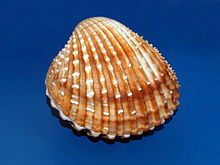| Acanthocardia tuberculata | |
|---|---|

| |
| One valve of the shell of Acanthocardia tuberculata from Sicily at the Museo Civico di Storia Naturale di Milano | |
| Scientific classification | |
| Domain: | Eukaryota |
| Kingdom: | Animalia |
| Phylum: | Mollusca |
| Class: | Bivalvia |
| Order: | Cardiida |
| Family: | Cardiidae |
| Genus: | Acanthocardia |
| Species: | A. tuberculata |
| Binomial name | |
| Acanthocardia tuberculata (Linnaeus, 1758) | |
| Synonyms | |
| |
Acanthocardia tuberculata, the rough cockle, is a species of saltwater clam, a cockle, a marine bivalve mollusc in the family Cardiidae. The genus Acanthocardia is present from the Upper Oligocene to the Recent.
Description
The shell of Acanthocardia tuberculata can reach a size of about 95 mm. This shell is robust, equivalve, inflated and slightly inequilateral, with crenulated margins. The surface shows 18-20 strong radial ribs, with rows of spiny nodules. The basic coloration is usually pale brown with alternating darker concentric bands.
Right and left valve of the same specimen:

Distribution and habitat
Acanthocardia tuberculata can be found in the Mediterranean Sea and in the Northeast Atlantic Ocean. This species is present in the continental shelf from low tide to 200 m. Like most other bivalves, these mollusks are suspension feeders filtering phytoplankton.
Subspecies
- Acanthocardia tuberculata citrinum Brusina, 1865
- Acanthocardia tuberculata tuberculata (Linnaeus, 1758)
- Acanthocardia tuberculata f. alba
Gallery
-
 Illustration of Acanthocardia tuberculata from Natural History: Mollusca (1854), p. 271
Illustration of Acanthocardia tuberculata from Natural History: Mollusca (1854), p. 271
-
Fossil of Anthocardia tuberculata, Pliocene, Asti (Italy)
References
- Repetto G., Orlando F. & Arduino G. (2005): Conchiglie del Mediterraneo, Amici del Museo "Federico Eusebio", Alba, Italy
- Biolib
- Encyclopedia of life
- World Register of Marine Species.
- Marine Species Identification
- Marine bivalve shells of the British Isles
| Taxon identifiers | |
|---|---|
| Acanthocardia tuberculata | |
This Cardiidae-related article is a stub. You can help Misplaced Pages by expanding it. |

